Only a few hundred years ago did man discover that an uncut diamond can be transformed into a faceted gem, and by doing so more light and beauty could be unleashed.
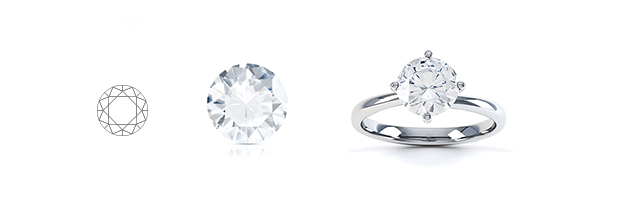
ROUND-BRILLIANT CUT DIAMOND
The round brilliant cut diamond is the most popular of all the diamond shapes, is a favorite for engagement rings, timeless beauty. Its history dates back over a century, and it is still as desired today as it was when it was first designed.
Developed by Marcel Tolkowsky in 1919, the thesis that he wrote described the ideal proportions of a round brilliant cut loose diamond to allow maximum light return. His specifications were followed for years. Diamond cutters and craftsmen have spent decades perfecting this cut diamond.
Polished to ideal proportion and symmetry, round brilliant cut diamonds radiate with optimum fire, brilliance and scintillation. This cut is often called an “open” cut which means it allows maximum light dispersion. The cut is designed for the optimal light refraction; light enters the top of the diamond (crown), and the maximum amount of light exits back out the top of the diamond.
The round shape has been linked to the personality characteristics of warmth, empathy and dependability. It is also a popular shape because it flatters all finger lengths and shapes.
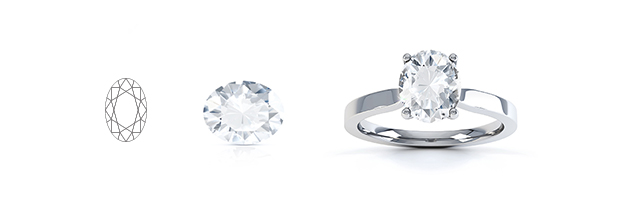
OVAL SHAPE DIAMOND
An oval shape diamond is an elongated version of a round brilliant diamond. When the diamond is cut perfectly it displays great brilliance, fire and scintillation.
The oval shape diamonds facets range between 56 to 58 and is essentially a round brilliant diamond with an elliptical shape rather than a round shape. It presents a larger surface area than a round diamond, giving the appearance of being larger than its caratage.
An oval shape diamond solitaire ring is ideal for those who wish to give the illusion of longer, thinner fingers.
The oval shape diamond can be linked with the personality traits such as creativity, individualism and risk-taking. The luster and fire achieved by this beautiful diamond shape makes it a popular choice for engagement rings.
It’s also a popular diamond shape among the rich and famous, with Princess Diana’s engagement ring (which is today worn by Kate Middleton) featuring one of the most famous examples of the oval cut.
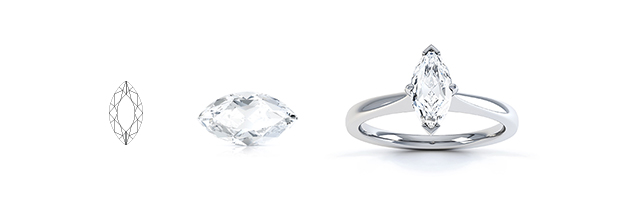
MARQUISE SHAPE DIAMOND
The marquise shape loose diamond was created for Louis the XIV, the King of France. Legend goes that Louis the XIV wanted a diamond that would match the brilliant smile of the Marquise of Pompadour. Because of its shape, it is sometimes known as “Navette” (little boat).
The marquise diamond has a slender elongated shape with two sharp points on either end of it. The standard number of facets on a Marquise diamond is 58. The elongated shape of the marquise gives it the appearance of a diamond that is larger in size.
The perfect proportions are required to achieve its distinctive shape. If it is shaped too long or too wide, it will not adhere to the marquise diamond’s specifications and therefore not give off the same amount of brilliance.
This is also of the "brilliant" type of diamonds and can be associated with the personality traits of the extroverted, innovative and ambitious. The eye-catching cut offers a unique charm.
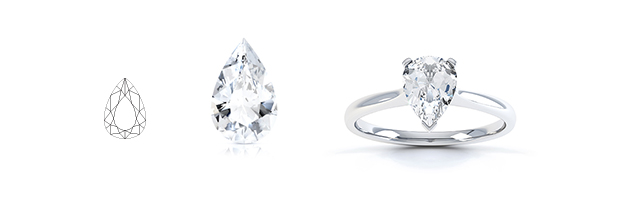
PEAR SHAPE DIAMOND
The pear shape diamond cuts are also known as “Teardrop shaped diamonds”. Created in 1458 by a Flemish diamond polisher, Lodewyk (Louis) van Berquem . The shape was praised for its beautiful shape.
The pear shape diamond has 58 facets and is mainly cut in the brilliant style. It is a unique cut and gives a depth of scintillation at the tip of the diamond. The ratio of the length to the width should ideally be about 1.5:1. This shape means the carat weight is higher at the rounded end of the diamond.
There have been various well-known pear shape diamonds. Elizabeth Taylor famously wore a 69.42 carat pear shaped diamond pendant she received from Richard Burton. The Millennium Star is a 203.04 carat, D color, flawless pear shaped diamond.
The pear shape has a majestic quality and is a striking option for a woman with alternative taste. Personality traits associated with the pear shape are that of being considerate, adventurous and sociable.

PRINCESS CUT DIAMOND
This diamond shape also known as “The square modified cut”, was first designed in the 1960s and was later perfected and named “Princess cut” in around 1980. This makes the princess cut a relatively new shape in the world of diamonds and is therefore considered very modern and contemporary.
A princess cut diamond is square in shape with up to 78 facets. When looked at from the side, it appears to resemble the shape of an inverted pyramid. It is a popular diamond for engagement rings.
The princess cut for diamonds must be deep, giving greater emphasis to the pavilion (bottom of the diamond and pointed corners. If not set well, and not looked after well, these corners can easily be chipped.
This shape is a version of the traditional round brilliant cut, because it displays numerous sparkling facets. It sparkles so much that it is said to have the same fire and scintillation as the round brilliant cut. The end result of the princess cut shape is a diamond that has the brilliance of the round brilliant, but with a different overall appeal.
The square shape of this cut is associated with independence, audacity and confidence. Thanks to its beauty, brilliance and striking appearance, it is easy to see why the princess cut diamond has become such a popular cut among modern day brides.

RADIANT CUT DIAMOND
A radiant cut diamond is considered a modified brilliant diamond, which takes on the elegance of the emerald shape diamond and the brilliance of the round brilliant cut diamond. It is closely related to the princess cut diamond.
First created in 1977 by Henry Grossbard, of the Radiant Cut Diamond Company (RCDC) this cut became popular in the 1980s. The radiant cut diamond length to width ratio is 1 to 1.2-1.5 and has 70 facets.
The square or rectangular shape of this diamond requires it to be cut with greater weight in the pavilion, in order to maximize the light that can enter and be refracted back to the eye. The facets of the radiant cut create the image of cracked ice within the diamond – a unique characteristic that sets it apart from other diamond cuts.
The radiant cut diamond is known for its brilliance and array of colors and therefore requires the skillful eye and detailed precision of an experienced craftsman. A radiant cut diamond is associated with energetic, spirited, social and exuberant personalities.
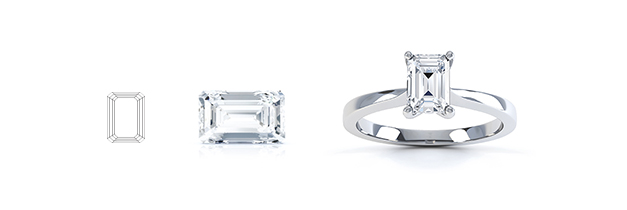
EMERALD CUT DIAMOND
The emerald cut diamond loose stones are rectangular in shape that has cut corners and step-cut facets which are usually parallel to the girdle – ‘step cut’ refers to the step-like look of the facet cuts. The cut itself was developed originally just for emerald gems, but was later also used for diamonds.
Emerald shaped diamonds have 50 to 58 facets, the number of facets depend on the number of rows on the crown and the pavilion.
This cut appears to have less brilliance due to the step-cut of the emerald diamond, but it is just a different and more subtle sparkle. The step-cut creates flashes of light that have a ‘hall of mirrors effect.’ This creates flashes of bright white light that act in contrast to the dark planes found in each step. These dramatic flashes of light give it an elegant and sophisticated appeal.
The emerald cut shape of diamond can be repetitive of organized, resourceful, disciplined and decisive personalities. There is a vintage appeal that is beautiful and distinct and resonates with women who appreciate the beauty of antique-style jewelry. Because of the versatility of this cut, a variety of shapes and settings work well with it. The emerald cut has been favored by the likes of Grace Kelly, Elizabeth Taylor and Angelina Jolie.
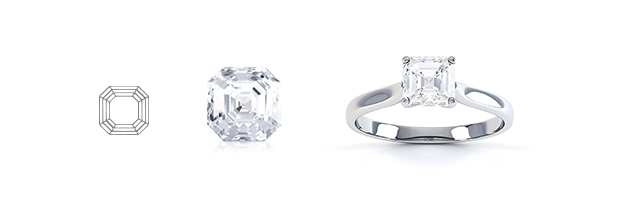
SQUARE EMERALD (ASSCHER) CUT DIAMOND
A square emerald cut diamond is also known as the Asscher cut. This shape was developed in 1902, and was named after its creator, Joseph Asscher of the Asscher Diamond Company.
The deep corners in this cut give the illusion of an octagon, the square emerald cut has a unique sparkle. It is a 57-facet diamond and has a square, step-cut shape which was the forerunner of the later emerald cut diamond. It has large step-cut facets, which are usually larger than the emerald cut. It has a deep pavilion, faceted/ polished culet, high crown and small table.
The square emerald cut is perfect for those who wish to express a sense of elegance and beauty. This cut is a typical example of an old diamond cut that never goes out of style and is therefore as popular today as it was when it was first created. This diamond cut was worn by royal families and aristocrats and many square emerald cut diamonds have been passed down as family heirlooms.
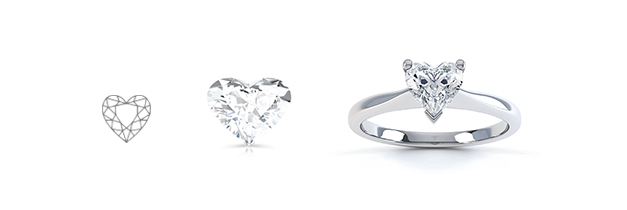
HEART SHAPED DIAMOND
The origin of this shape came from the pear shape diamond, the heart shape was directly derived from it. The heart shape diamond starts off as a pear shape. It is very important to have an experienced diamond cutter, to ensure the distinctive lobes are balanced, smooth and well defined, while retaining the diamonds brilliance.
Because it is a brilliant cut, the heart shaped diamond brilliance can match that of a round brilliant cut diamond. It features 59 facets, each one polished to perfection to achieve the maximum amount of brilliance.
The heart diamond shape is a modified brilliant diamond and can vary greatly in length and width. The ideal length to width ratio is 1 to 1. The setting itself should have five prongs to ensure security, stability and protection.
An age-old romantic symbol of love, the heart is an ideal pendant diamond. It is favored as a Valentine’s Day or birthday gift, and is not often set in an engagement ring. It is sometimes also favored for earrings. Personalities drawn to the heart shape of diamond tend to be sentimental, sensitive and romantic.